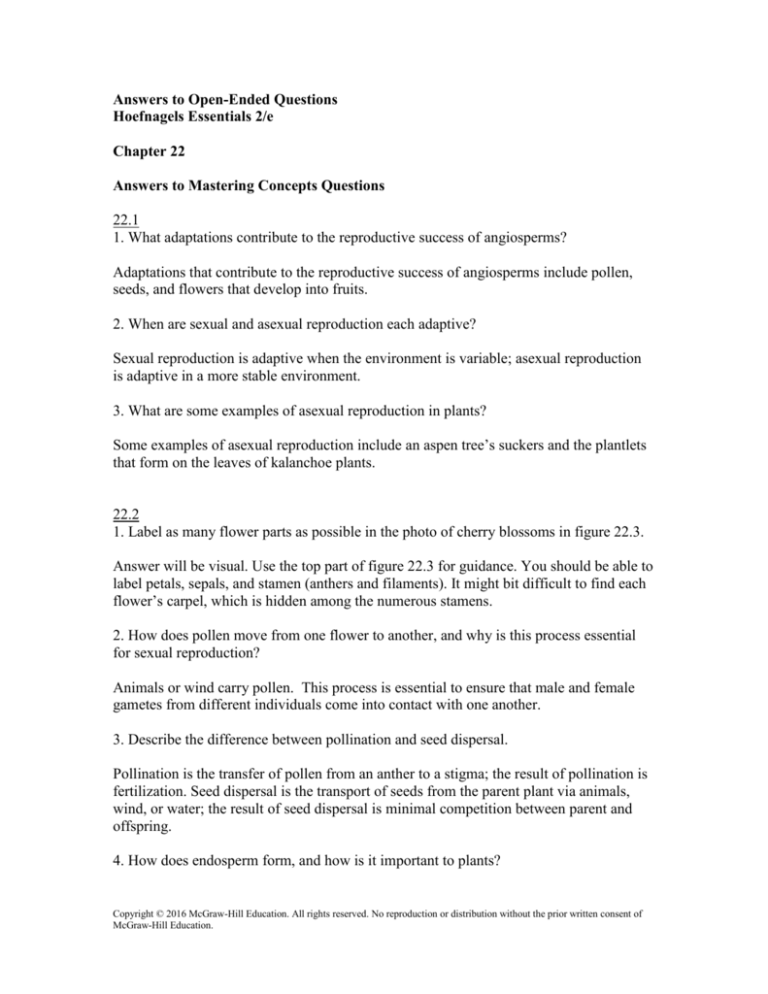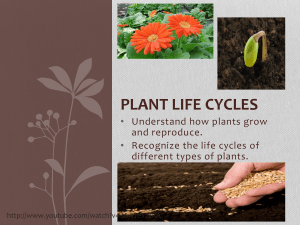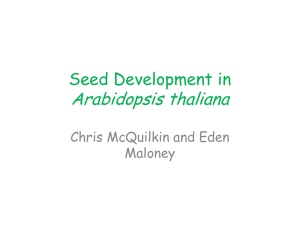
Answers to Open-Ended Questions
Hoefnagels Essentials 2/e
Chapter 22
Answers to Mastering Concepts Questions
22.1
1. What adaptations contribute to the reproductive success of angiosperms?
Adaptations that contribute to the reproductive success of angiosperms include pollen,
seeds, and flowers that develop into fruits.
2. When are sexual and asexual reproduction each adaptive?
Sexual reproduction is adaptive when the environment is variable; asexual reproduction
is adaptive in a more stable environment.
3. What are some examples of asexual reproduction in plants?
Some examples of asexual reproduction include an aspen tree’s suckers and the plantlets
that form on the leaves of kalanchoe plants.
22.2
1. Label as many flower parts as possible in the photo of cherry blossoms in figure 22.3.
Answer will be visual. Use the top part of figure 22.3 for guidance. You should be able to
label petals, sepals, and stamen (anthers and filaments). It might bit difficult to find each
flower’s carpel, which is hidden among the numerous stamens.
2. How does pollen move from one flower to another, and why is this process essential
for sexual reproduction?
Animals or wind carry pollen. This process is essential to ensure that male and female
gametes from different individuals come into contact with one another.
3. Describe the difference between pollination and seed dispersal.
Pollination is the transfer of pollen from an anther to a stigma; the result of pollination is
fertilization. Seed dispersal is the transport of seeds from the parent plant via animals,
wind, or water; the result of seed dispersal is minimal competition between parent and
offspring.
4. How does endosperm form, and how is it important to plants?
Copyright © 2016 McGraw-Hill Education. All rights reserved. No reproduction or distribution without the prior written consent of
McGraw-Hill Education.
Endosperm forms by double fertilization, during which one sperm nucleus fertilizes the
egg (forming the zygote) and the other one fertilizes the two nuclei in the central cell
(forming the endosperm). The endosperm nourishes the young plant until it begins
producing its own food by photosynthesis.
5. What are the components of a seed?
The seed is an embryo and stored food surrounded by a seed coat.
6. Which flower parts develop into a fruit?
The ovary is the flower part that develops into a fruit. Other parts of the flower,
including the receptacle, may also develop into fruit parts.
7. What are the two main functions of fruits?
Fruits protect developing seeds and promote their dispersal once they are mature.
22.3
1. Why must seeds absorb water before germinating?
The seed expands as it absorbs water, which helps the seed coat to split and exposes the
embryo to oxygen. In addition, absorption of water causes the embryo to release
hormones that trigger the production of enzymes that digest stored starch, which will
nourish the young seedling until it begins to produce its own food by photosynthesis.
2. What are the events of early seedling development?
After seed germination, cells in the embryo’s apical meristems divide to form shoots and
roots. Gravity stimulates the downward growth of roots. At first, the only source of
energy is stored food from the seed, but the seedling produces its own food by
photosynthesis once leaves form on the seedling’s stem.
3. How does natural selection influence seed size?
Seed size reflects a tradeoff between nutrient storage and dispersal. Small seeds can
disperse far away from the parent plant, but they contain little energy to sustain early
seedling growth. Conversely, large seeds contain abundant energy but may not disperse
easily to new habitats.
Copyright © 2016 McGraw-Hill Education. All rights reserved. No reproduction or distribution without the prior written consent of
McGraw-Hill Education.
22.4
1. What is a hormone?
A hormone is a biochemical synthesized in small quantities that is transported to other
locations in the organism, where it stimulates or inhibits a response in the target cells.
2. How does a plant hormone exert its effects?
Plant hormones bind to a receptor protein on or in a target cell, stimulating chemical
reactions that alter the expression of one or more genes.
3. List the major classes of plant hormones and name some of their functions.
Answers should be based on table 22.2. Auxins cause shoot tips to elongate, stimulate the
growth of roots from stem cuttings, inhibit growth of lateral buds, and participate in
responses to light and gravity. Cytokinins stimulate cell division and the growth of lateral
buds. Gibberellins cause roots, shoots, and young leaves to elongate, and they break seed
dormancy. Ethylene ripens fruits, stimulates leaves and flowers to age and drop from
plant, and participates in a plant’s response to touch. Abscisic acid inhibits shoot growth,
keeps buds and seeds dormant, stimulates protein storage in seeds, and stimulates stomata
to close.
4. Give an example of how plant hormones interact.
Auxins are most concentrated in shoots, whereas cytokinins are most concentrated in
roots. Cytokinins move upward in the plant and stimulate lateral buds to sprout. In
contrast, auxins move downward in a plant shoot, suppressing the growth of lateral buds.
If the terminal buds are pinched off, the plant will become bushy, as cytokinin-influenced
growth of lateral buds occurs. If terminal buds remain in place, the plant will grow tall
instead of bushy.
22.5
1. What is auxin’s role in phototropism?
Auxin moves to the shaded side of a shoot, where it triggers elongation of shaded cells.
Thanks to unequal cell growth on opposite sides of a shoot, the plant bends toward light.
2. How does light help regulate flowering time?
Long-day/short-night plants flower only when days grow longer than a critical length,
usually 9 to 16 hours. These plants usually bloom in the spring or early summer. In
contrast, short-day/long-night plants flower only when light periods become shorter than
some critical length, typically in late summer or fall. Despite these definitions, flowering
in these plant species actually depends on the length of the uninterrupted dark period, not
the day length.
Copyright © 2016 McGraw-Hill Education. All rights reserved. No reproduction or distribution without the prior written consent of
McGraw-Hill Education.
22.6
1. How do plastids and auxins participate in gravitropism?
Starch-rich plastids are the gravity detectors in the root cap cells. The plastids sink to the
bottom of the cells, distributing auxins in a way that bends the root downward.
2. How does thigmotropism help plants climb?
Thigmotropism is a response to touch in a specialized structure such as a tendril.
Hormones cause differential growth in the tendril, allowing it to encircle physical
supports such as a trellis or the branches of another plant.
Write It Out
1. Give an example of asexual reproduction in a plant.
Answers may vary; the suckers that grow from the roots of a cherry tree are one correct
example.
2. Explain how flowers, fruits, and seeds contribute to the reproductive success of
angiosperms.
Flowers bring together the egg and sperm. The fruit protects the seed and helps ensure its
dispersal. The seed protects the dormant embryo and nourishes the young seedling after
germination.
3. Describe the male and female gametophytes of flowering plants.
The male gametophyte is a two-celled, thick-walled, haploid pollen grain. Female
gametophytes are embryo sacs, each of which contains eight haploid nuclei and seven
cells. The central cell of the embryo sac contains two nuclei. One of the other six cells is
the egg.
4. What is double fertilization? How does it increase the reproductive success of the
parent plant?
The pollen grain produces two haploid sperm nuclei. During double fertilization, these
two nuclei simultaneously fertilize the nuclei in the central cell and egg cell of the
embryo sac. Fertilization of the nuclei in the central cell produces the endosperm,
whereas fertilization of the egg cell produces the zygote. The zygote develops into the
embryo, which uses the separately developing endosperm as a food source. Endosperm
formation increases the reproductive success of the parent plant because a well-nourished
embryo is more likely to survive long enough to begin photosynthesis on its own. In
addition, double fertilization saves energy because it ensures that the plant does not invest
in endosperm formation unless a sperm nucleus has actually fertilized the egg.
Copyright © 2016 McGraw-Hill Education. All rights reserved. No reproduction or distribution without the prior written consent of
McGraw-Hill Education.
5. How does an exclusive relationship between a plant and its pollinator benefit each
partner? What are the risks of exclusivity?
The benefit to the pollinator is that it is assured a specific nutrient source that will meet
its needs and that will be relatively inaccessible to competitors. The plant benefits
because its pollen is specifically delivered to plants within its species, cutting down on
the number of sperm that need to be produced. Both partners are at risk, however, if the
other goes extinct. If the remaining partner is too specialized, it may not be able to
survive.
6. If fruit production is a measure of fitness, why wouldn't a plant spend all of its energy
producing fruits instead of roots and leaves? Why do you think some annual plants die
back as they produce fruits and seeds?
Seeds and fruits cannot develop in the absence of roots and leaves, which ensure that
water, minerals, and sugars are available for reproduction. If a plant dies back as it
produces fruit and seeds, then more of its energy can go into reproduction, since energy is
no longer needed to maintain roots and leaves.
7. An oak tree may produce thousands of acorns, which squirrels bury or eat. Why does
the tree make so many acorns? Why might a tree whose seeds disperse far from the
parent have better reproductive success than one whose seeds fall at the base of the parent
plant?
Most of the acorns will never develop into new trees. Many will rot or be eaten by
animals, some may not be viable, and many will land in unsuitable habitats. Dispersing
seeds far from a parent plant reduces competition for light, water, and nutrients between a
plant and its offspring.
8. How do fruits and seeds disperse to new habitats?
Seeds are contained within fruits, which may be dispersed to new habitats via wind,
water, or animals. Many fruits offer nutrients to animals, which will eat them and deposit
the seeds later in droppings. Other fruits have hooks on their surface that catch on
mammal fur.
9. How does seed dormancy promote reproductive success?
Seed dormancy allows a seed to germinate in favorable conditions, rather than in the cold
winter months when sunlight is scarce and water is frozen in the soil.
10. List the major plant hormones and describe some of their actions.
Copyright © 2016 McGraw-Hill Education. All rights reserved. No reproduction or distribution without the prior written consent of
McGraw-Hill Education.
Auxins promote cell elongation. Cytokinins stimulate cell division in seeds, roots and
fruits. Gibberellins stimulate stem elongation and seed germination. Ethylene hastens
fruit ripening. Abscisic acid induces and maintains seed dormancy.
11. How does pruning stimulate the growth of new branches on a shrub?
Removal of a shoot tip decreases the concentration of auxins and increases the
concentrations of cytokinins at the lateral buds. This hormonal signal triggers new branch
growth.
12. What is the function of photoreceptors?
Photoreceptors detect the quality and quantity of light.
13. Describe three tropisms. Which hormone is common to all three?
Three tropisms are phototropism (growth toward or away from light), gravitropism
(growth toward or away from gravity), and thigmotropism (growth toward or away from
a mechanical stimulus). Auxins are hormones that participate in all three.
14. Explain how plants grow toward light. Why is this response adaptive?
Directional light causes auxins to accumulate on the shaded side of the plant. Cells with
abundant auxins have “stretchier” cell walls, so they elongate as they take in water. As
cells elongate more on the shaded side of the plant than on the light side of the plant, the
stem bends toward the light. Bending toward the light is adaptive because it maximizes
the leaf surface area exposed to light, so the plant can produce more sugars to use in
growth and reproduction.
15. Develop a hypothesis that explains why it might be adaptive for a plant to flower in
response to photoperiod rather than temperature.
Answers will vary. One possible hypothesis is that day length is a more reliable indicator
of the time of year than is temperature. Accurate detection of season can affect
reproductive success; pollinators may not be available if a plant flowers too early or too
late.
16. How is gravitropism adaptive?
Gravitropism ensures that stems will grow upward (in the direction of light) and that
roots will grow downward (in the direction of water and nutrients in the soil).
Copyright © 2016 McGraw-Hill Education. All rights reserved. No reproduction or distribution without the prior written consent of
McGraw-Hill Education.
Pull It Together
1. Add the following terms to the concept map: stamen, anther, carpel, ovule, stigma.
“Pollen” connects with the phrase “is produced at the” to “anther,” which in turn
connects with the phrase “is part of a” to “stamen.” “Ovary” connects with the phrase “is
at the base of the” to “carpel.” “Ovary” also connects with the phrase “contains one or
more” to “ovules.” “Stigma” connects with the phrase “is at the top of the” to “carpel”
and connects with the word “receives” to “pollen.”
2. Name tissues or cells that are haploid, diploid, and triploid.
Haploid cells in the pollen grains and embryo sac produce the haploid sperm nuclei and
egg cells. Diploid cells include the zygote and the rest of the sporophyte body. Triploid
cells include the endosperm.
3. What roles do animals play in plant life cycles?
Animals carry pollen from flower to flower. Animals also scatter seeds in their feces, or
seeds can be carried in animal fur.
4. What hormones are involved in plant development?
Review figure 22.19. Auxins, cytokinins, gibberellins, abscisic acid, and ethylene are the
major hormones involved in plant development.
5. List examples of environmental conditions that influence plant development.
Light has the largest influence on plant development, because the amount of light
ultimately limits energy production. Gravity also influences the direction of root and stem
growth. Water availability affects root growth and the adaptations of the stem and leaves.
Temperature and moisture both affect seed germination. Wind and other mechanical
stimuli also affect plant growth.
Copyright © 2016 McGraw-Hill Education. All rights reserved. No reproduction or distribution without the prior written consent of
McGraw-Hill Education.









